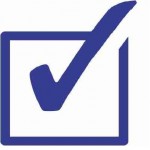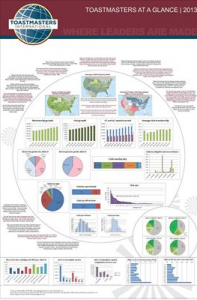The annual Toastmasters business meeting is where we elect the board of directors, international officers, and amend our governing documents.
Clubs not assigned to a district (“undistricted clubs”) are assigned to a district director as a proxy option, and so it is possible for districts to get more than 100% of “their” proxies for the business meeting. None did that this year. The percent of clubs represented has varied from 66.1% in 2022, to 70.0% last year, to a new high of 70.3% this year (quorum is one-third).
The districts with the best percentage of club proxies were:
- D90 (northern NSW, Australia), got 100.0%, 127 proxies out of 127 paid clubs.
- D97 (Cambodia, Laos, Myanmar, Thailand, Vietnam), 100.0%, 62 out of 62.
- D70 (southern NSW and ACT, Australia), 99.3%, 133 out of 134 (missing 1 club).
- D20 (Bahrain, Kuwait, Egypt, Iraq), 99.1%, 105 out of 106 (missing 1 club).
- D74 (southern Africa), 97.4%, 111 out of 114 (missing 3 clubs).
At the other end of the scale, we had:
- D114 (eastern Africa), 21.4%, 18 out of 84.
- D89 (Hong Kong, Macau, Fujian, Hainan and part of Guangdong, China), 25.6%, 22 out of 86.
- D79 (Saudi Arabia), 30.6%, 37 out of 121.
The top quarter of districts achieved or exceeded 86% representation, the top half (median) reached 71% or more, and the top 3/4 beat 56%.
The top regions were:
- Region 13 (southern Asia, India to Singapore), 88.0%
- Region 12 (Australia, New Zealand), 79.8%.
The vast majority of the votes come from clubs (98.7%, two per club), the rest are “at large” members, which is any current or past International Director who is a member in good standing (including International Presidents and officers), and the current District Directors (they each get one vote, regardless of any clubs they also may represent). At-large votes cannot be assigned to someone else (unlike clubs).
Undistricted clubs are randomly assigned a default district director for their proxy, which they can choose to assign the proxy to (they can assign it to anyone, just like all other clubs). That’s why there’s no “U” line in the spreadsheet (and that’s why a district can have more than 100% of the proxies, compared to the number of clubs they have). There is no public listing of which districts the “U” clubs were assigned to.
Of those votes from clubs, the large majority are represented by the District Directors. There’s no way of knowing just how many, but based on my observations over the years, probably 70-80% or more. There’s always people with proxies from a few clubs, but very few relative to what the DDs have.
While there are many more important things for Toastmasters districts to devote scarce resources to (like helping struggling clubs and building new clubs), collecting proxies shouldn’t be that hard to do. A district proxy chair with a committee to call clubs and round up proxies makes an excellent project!
Full details in the Excel spreadsheet here: Proxies-2024
Here’s my post on the 2023 proxy returns.


 There are various opinions on this topic, and I researched it a few years ago, using old contest programs from division contests and higher. With ten contests in a few days, and 88 contestants, the 2013 semi-finals and finals looked like a great opportunity to revisit this.
There are various opinions on this topic, and I researched it a few years ago, using old contest programs from division contests and higher. With ten contests in a few days, and 88 contestants, the 2013 semi-finals and finals looked like a great opportunity to revisit this. I’ve seen lots of interesting infographics from other organizations, but never one for Toastmasters, so I created my own, a 24″x36″ poster, and had 1,000 copies printed to hand out at the convention this month. They were quite popular, all given away in just three evenings, almost all just one at a time. Some people even asked me to autograph them!
I’ve seen lots of interesting infographics from other organizations, but never one for Toastmasters, so I created my own, a 24″x36″ poster, and had 1,000 copies printed to hand out at the convention this month. They were quite popular, all given away in just three evenings, almost all just one at a time. Some people even asked me to autograph them!